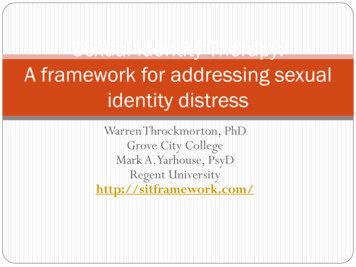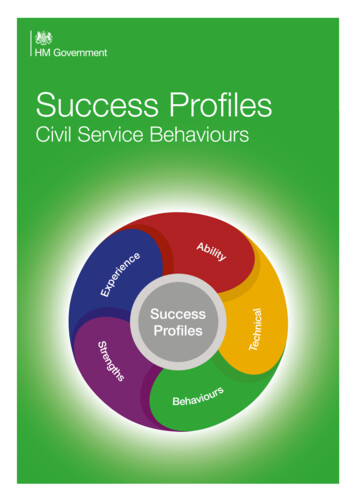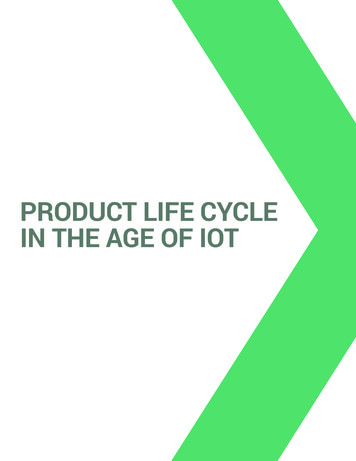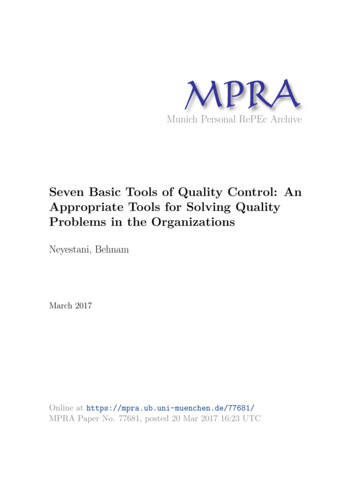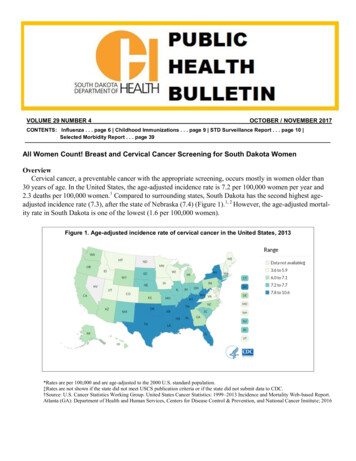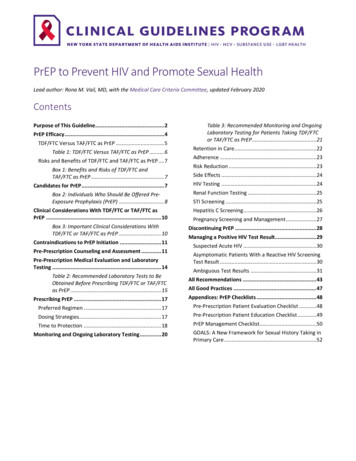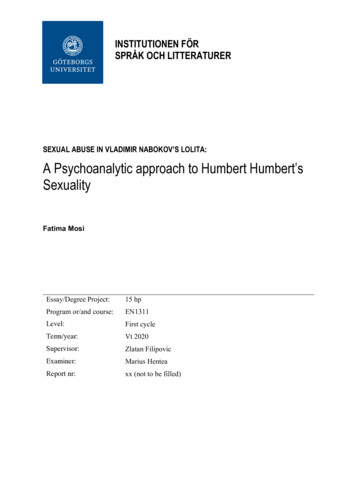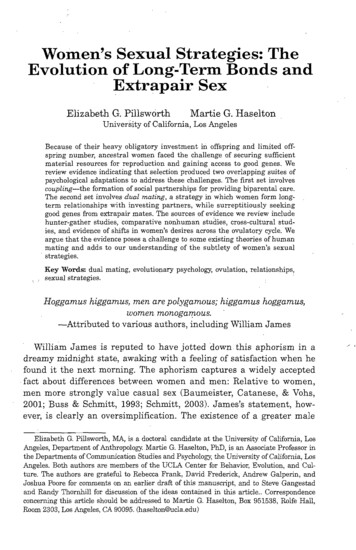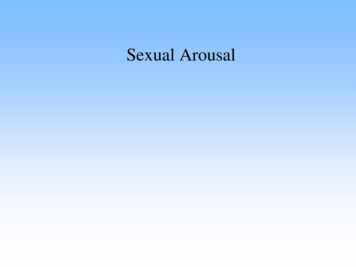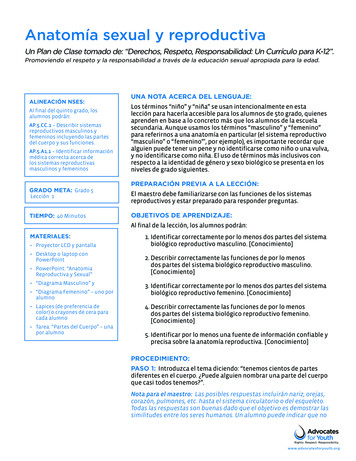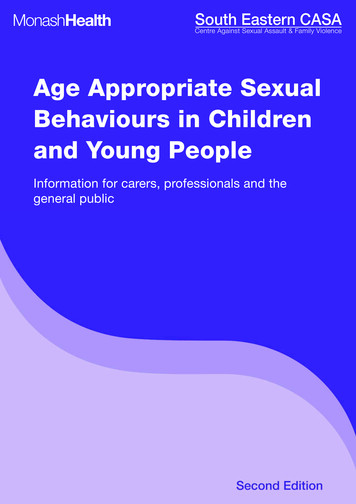
Transcription
MonashHealthSouth Eastern CASACentre Against Sexual Assault & Family ViolenceAge Appropriate SexualBehaviours in Childrenand Young PeopleInformation for carers, professionals and thegeneral public
Published by South Eastern Centre Against Sexual Assault & Family Violence (SECASA)PO Box 72East Bentleigh 3165Tel: 03 9928 8741For all enquiries about this book please contact South Eastern Centre Against Sexual Assault &Family Violence (SECASA).First version published in June 2007 with endorsement by the Statewide Steering Committee toReduce Sexual Assault.This revised version was published by South Eastern Centre Against Sexual Assault & Family Violence(SECASA) in November 2017 to assist carers, professionals and the general public to more easilyunderstand what is sexually appropriate behaviour, concerning behaviour and very concerningbehaviour in children and young people.DisclaimerWhile every effort has been made to ensure its accuracy at the date of publication, the informationin this book is in the nature of general comment and guidance only. It should not be interpreted asclinical or legal advice, nor should it be taken as being completely free of any error or omission. TheSouth Eastern Centre Against Sexual Assault & Family Violence and Monash Health expresslydisclaim any liability to any person in respect of any loss, damage, or injury of any kind which may becaused by or result from reliance on, use of, or dissemination of any kind of information contained inthis book. Copyright South Eastern Centre Against Sexual Assault and Family Violence 2017.The copying or reproducing any part of this book for non-commercial purposes is permittedprovided that SECASA is acknowledge as the publisher.
ContributorsAuthors of the original version: Mark Barnett – Victoria Police Ada Giaquinto and Lise Hunter – Australian College of Applied Psychology Carolyn Worth AM – South Eastern Centre Against Sexual Assault & Family ViolenceIn conjunction with the early Intervention and Response Pathways Sub-Committee of theStatewide Steering Committee to Reduce Sexual Assault Committee Members: Virginia Dods Karen Hogan Patrick Tidmarsh Carolyn Worth AMWe would like to thank the following individuals and organisations for their support and critical inputinto this book: Karen Hogan – Gatehouse Centre, Royal Children’s Hospital Helen Kamborides – Gatehouse Centre, Royal Children’s Hospital Russell Pratt, SABTS Project Worker Jackie Bateman, Team Leader SECASA AWARE Susan McDougall, Team Leader SECASA Carolyn Worth AM Mary LancasterAge Appropriate Sexual Behaviour in Children and Young People: 2nd EditionPage 1 of 42
Age Appropriate Sexual Behaviour in Children and Young People: 2nd EditionPage 2 of 42
Definitions . 5Purpose of this book . 7Things to consider about sexual behaviour . 9Influences on children and young people’s sexual behaviour . 9Values about sexuality . 9Sexual development and sexual behaviours . 9Issues arising from the use of technology. 10Classifying the sexual behaviours discussed in this book . 11Breakdown of age and developmental groups . 12Disability and cognitive impairment . 12How to use this book . 131.Determine if the sexual behaviour is normative, concerning or very concerning . 132.Determine the context for the behaviour . 133.Decide how to respond . 13Determining if the sexual behaviour is normative or concerning. 150 – 4 years: infant, toddler, pre-school (Ref: Gil, 1993 and Cavanagh Johnson 1999) . 155 – 9 years: early school years (Ref: Gil, 1993 and Cavanagh Johnson 1999) . 169 – 12 years: pre-adolescence (Ref: Ryan 2000, and Ryan, Lane and Leversee) . 1713 – 18 years: adolescence (Ref: Ryan, Lane and Leversee and LaTrobe University 2014Health Study) . 18Context of the sexual behaviour . 19How to respond. 21What to do . 22What not to do . 22Referring a child or young person for further professional help . 23When to refer a child aged 0 to 9 years . 23When to refer a child/young person aged 10 to 18 years . 23What happens when a referral is made? . 24Frequently asked questions . 25Case examples . 29Seek further advice or make a referral . 35Age Appropriate Sexual Behaviour in Children and Young People: 2nd EditionPage 3 of 42
Age Appropriate Sexual Behaviour in Children and Young People: 2nd EditionPage 4 of 42
DefinitionsThe following definitions are used in this book:Children and young people generallyAge of criminal responsibilityAge of consent to sexual activityCarersProfessionals who work with childrenand young peopleNormative, or age appropriate,sexual behaviourProblem sexual behaviour (PSB)*Sexually abusive behaviour (SAB)Sexualised behavioursThose aged 0 - 18 years10 years and over (in Victoria)12 years and over (in Victoria) Foster carers Kinship carers Residential care workers Group home parents Parents Child-care workers Pre-school teachers Primary school teachers Educators Community health workers Maternal and child health nurses School counsellors Family day carers Out of hours school care coordinators Social workers Psychologists Counsellors Welfare workers Youth workers Corrections staffSexual behaviour that is part of the normal growing upprocess. Normative behaviours change over time.As defined in Victoria’s Children, Youth and Families Act(2005) – other states may use different terminology.Behaviours by children under 10 years that may causeharm to themselves or others. These behaviours may belisted in this book as ‘concerning’ or ‘very concerning’.As defined in Victoria’s Children, Youth and Families Act(2005) – other states may use different terminology.Behaviours listed in this book as ‘concerning’ or ‘veryconcerning’ by children/young people 10 years and over.A commonly used term for problematic and sexuallyabusive behaviours grouped together.*Sexually abusive behaviour treatment programs are provided by several agencies in Victoria.Contact details are given in “Seek further advice or make a referral”.Age Appropriate Sexual Behaviour in Children and Young People: 2nd EditionPage 5 of 42
Age Appropriate Sexual Behaviour in Children and Young People: 2nd EditionPage 6 of 42
Purpose of this bookDetermining what is age appropriate sexual behaviour is a challenge for all those who work withchildren and young people.This book provides information which may help you to: Understand what is normative (age appropriate) sexual behaviour and sexual behavioursthat are concerning, and very concerning (abusive) Determine when you should be concerned about a child or young person’s sexual behaviour Determine when further professional advice is required, and know who to contact.This updated second edition includes the impact of online and digital activities on children andyoung people’s behaviours which are challenging carers and professionals in new ways.With sexting and sending naked images, questions are being asked such as: Are these activities appropriate? Are these behaviours legal? Are they part of normative behaviour and adolescent flirting, or abusive behaviour?The problem is not that young people use technology. It is appropriate for them to developtechnology skills and knowledge that they will need throughout their life.Problems arise when young people use technology to engage in sexually problematic or abusivebehaviours, which at times may be seen as bullying or blackmailing others, transmitting images orvideos that are illegal under current legislation, or come into contact online with people who seek toexploit them.We know that if concerning sexual behaviours are notresponded to early, problems may emerge in children andyoung people’s sexual development.We also know that some children and young people aremore at risk of developing concerning sexual behaviours.Age Appropriate Sexual Behaviour in Children and Young People: 2nd EditionPage 7 of 42
Age Appropriate Sexual Behaviour in Children and Young People: 2nd EditionPage 8 of 42
Things to consider about sexual behaviourInfluences on children and young people’s sexual behaviourThere are many influences on children and young people’s sexual behaviour. Most problem sexualbehaviours are not due to a background history of sexual abuse. Age appropriate sexual behaviourscan become disrupted in children and young people for several reasons. These include but are notlimited to: Accidental/non-accidental exposure to sexually explicit material such as internetpornography, or other forms of pornography Exposure to adult sexual activity Physical abuse and emotional neglect (cumulative harm) Being exposed to family violence Re-enacting one’s own childhood abuse Loss of significant others.Values about sexualityWhen we evaluate children and young people’s sexual behaviours, it is important that we considerand understand our own values about sexuality and sexual practices. There have been many changesover the past 30 years in mainstream Western attitudes about sex. Because of this some childrenand young people are increasingly exposed to sexual themes in their homes, amongst their peers,whilst online and via other media exposure.It is clear that today’s sexual environment is different from the environment in which many carersand professionals grew up. Our views on what is appropriate and what is normative may not be auseful or accurate guide to what passes for ‘OK’ or ‘normal’ today.To help us make decisions about what is age appropriate sexual behaviour, and what is concerning,it may be useful to refer to information in this book rather than rely on assumptions based onpersonal experience or values. This book is intended to help you make an objective evaluation orassessment.Sexual development and sexual behavioursChild development incorporates physical, emotional, cognitive and sexual development. Childrenand young people develop sexually, just as they do emotionally, mentally, cognitively and physically.The range of normative, age appropriate sexual behaviour changes as a child or young person growsand develops.Most sexual behaviour displayed by children and young people will “sit within” a normativedevelopment range. The challenge for carers and professionals is to identify sexual behaviours thatfall outside this range and then assist the young person to seek help for those problematicbehaviours.Age Appropriate Sexual Behaviour in Children and Young People: 2nd EditionPage 9 of 42
Issues arising from the use of technologyThe internet has become a source of increasing concern for parents and professionals, given theavailability of sexually explicit materials and the presence of online predators.Emerging research suggests that there are negative impacts on sexual development and behavioursin children and young people if they are under 12 years of age when they begin viewing pornography(For example: Skau, Bente, “Who Has Seen What When? Pornography’s Contribution to the SocialConstruction of Sexuality During Childhood and Adolescence” (2007)). It seems that these childrendo not have the emotional or sexual maturity to ‘decode’ pornographic images.There are also concerns around children being groomed online and young people using technologyto record others and then sharing inappropriate images.Young people should be educated and assisted to understand how online sexual content and activityfits in with relationships, romance and sex, and that some restrictions and supervision are necessaryfor their own protection.Professionals who identify children exhibiting problematic and sexually abusive behaviours that maybe driven by exposure to pornography, should: Ensure they have a good understanding of child development principles, including ages andstages Understand cyber-safety strategies and e-safety principles relevant for those ages andstages, and be competent and comfortable in talking with children and young people aboutthese issues Be able to refer a child to other professionals who are skilled in this area, if they are notcomfortable talking about these issues themselves.It is important to respond quickly to sexually problematic or abusive behaviours. Current research(Caldwell, M.F. January 2016: Quantifying the Decline in Juvenile Sexual Recidivism Rates Psychology Public Policy and Law) informs us that very few children and young people will go on tobecome adult sexual offenders. Children and young people respond well to treatment. However, fora very small number of children and young people these emerging patterns may continue intoadulthood.Age Appropriate Sexual Behaviour in Children and Young People: 2nd EditionPage 10 of 42
Classifying the sexual behaviours discussed in this bookThis book talks about 3 ranges, or classifications, of sexual behaviour: age appropriate (normative),concerning and very concerning. We have colour coded these to assist understanding:“Green shading”“Orange shading”“Red shading”Age appropriate sexual behavioursBehaviours that fit somewhere in the range between normativeand concerningBehaviours that fit somewhere in the range between concerningand very concerning (abusive)More information for each range is as follows:Age appropriate sexual behavioursSex play and sexual behaviour is normal in children and young people. They: Do not require intervention by carers or professionals. May be accompanied by laughter, spontaneity, curiosity and experimentation.Children are easily diverted from these behaviours.Age appropriate use of technology has little or low risk for sexually abusive behaviours. Thisuse is described here to give a context for higher risk uses described below.Concerning sexual behavioursThe frequency and persistence of these behaviours should be monitored.Seek professional advice if a child or young person exhibits several of these behaviours,and/or the behaviours continue despite clear requests to stop.Risks with technology use include less time with peers, grooming, viewing inappropriatecontent.Very concerning sexual behavioursSeek professional advice, especially if a child or young person is also secretive, anxious ortense - or if coercion, compulsion or threats are involved.Some of these behaviours become criminal offences when a young person reaches the age ofcriminal responsibility (10 years of age in Victoria, Australia). Report criminal offences to thepolice immediately.Technology use risks include: grooming, sexual assault, pornography, exploitation.Age Appropriate Sexual Behaviour in Children and Young People: 2nd EditionPage 11 of 42
Breakdown of age and developmental groupsWe have broken down these ranges of sexual behaviours into four (4) age and developmental stagegroupings: 0 – 4 years 5 – 9 years 9 – 12 years 13 – 18 years.This breakdown is based on recognised theories of developmental ages and stages as defined bymany of the child-development theorists (for example: Piaget, Erikson).These groupings should be viewed with caution, allowing for variations. They are only a guidebecause: Individual children and young people within a group will develop at different rates, and They may be exposed to different levels of family, peer and social influences about sexuality.The groups can also be broken down further into ‘sub-stages’, to define important developmentalmilestones within each stage. For example the age group 0 – 4 years covers three developmentalstages: Infant Toddler Pre-schooler.Disability and cognitive impairmentChildren or young people who are intellectually disabled or developmentally delayed experiencenormal physical sexual development. These children and young people are over represented in thepopulation of young people displaying problem or sexually abusive behaviours. Their behaviourshould not be ignored because of the disability or developmental delay, and chronological ratherthan emotional age should be used when making decisions about appropriate behaviour.Intellectual disability makes these children and young people more vulnerable to exploitation. Theirproblematic and sexually abusive behaviour can also have an adverse impact on themselves andother children and young people around them.Cognitive impairment issues, and the growing cohort of children and young people who present withAutism Spectrum Disorder (ASD), Attention Deficit Disorder (ADD) and Attention DeficitHyperactivity Disorder (ADHD) driven behaviours, present particular issues for those who work inthis field. The impact of these issues can mean that children and young people struggle tounderstand the social rules around sexual practices and relationships. Fixations may also emerge,particularly around online sexually explicit materials, and may develop quickly if not detected andmanaged early.Do not underestimate the appeal of sexually explicit materials to a young person on the autismspectrum, especially when this is paired with masturbation and other sexual stimulation.Age Appropriate Sexual Behaviour in Children and Young People: 2nd EditionPage 12 of 42
How to use this book1. Determine if the sexual behaviour is normative, concerning or very concerningRefer to the charts in the section: “Determining if the sexual behaviour is normative or concerning”to determine if a sexual behaviour is normative, concerning or very concerning for a child or youngperson in one of our defined age/development groups.Important:The sexual behaviours described in this book are not an exhaustive list and must not be used as anassessment tool if sexual abuse is suspected. In such cases, contact the relevant governmentreporting body – for example, Department of Health and Human Services Child Protection Service inVictoria. (See list of agencies in “Seek further advice or make a referral” section).2. Determine the context for the behaviourThink about what was happening in the child or young person’s life when the behaviour took place.To make an appropriate evaluation it is important to consider this context. See the section: “Contextof the sexual behaviour” for more information.3. Decide how to respondHow you respond to the child or young person is very important. The section: “How to respond” hasideas on what you might do and say when faced with these behaviours.Have a question?The “Frequently asked questions” section has answers to commonly asked questions. The “Caseexamples” section gives examples of the types of situations faced by people working with childrenand young people who are displaying sexualised behaviours.Want further advice, or need to make a referral?If, after becoming aware of a child or young person’s sexual behaviour and assessing the context,you are concerned that their behaviour is inappropriate, seek further professional advice or refer thechild or young person to a relevant agency.The “Referring a child or young person for further professional help” section explains when to refera child aged 0 – 9 years or a child/young person aged 10 – 18 years, and what happens when areferral is made.The “Seek further advice or make a referral” section has contact details for several agencies inVictoria that: Can provide further advice Will take referrals for assessment of the child or young person Can provide treatment programs for problem sexual behaviour (PSB) and sexually abusivebehaviour (SAB).This section also includes internet sites that can assist you to work with children and young peopleso that they can be “web-savvy” and web safe.Age Appropriate Sexual Behaviour in Children and Young People: 2nd EditionPage 13 of 42
Age Appropriate Sexual Behaviour in Children and Young People: 2nd EditionPage 14 of 42
Determining if the sexual behaviour is normative or concerningUse the information in this section to determine if the sexual behaviour is age-appropriate,concerning or very concerning, for a child or young person in the 4 age and developmental groups:0 – 4 years: infant, toddler, pre-school (Ref: Gil, 1993 and Cavanagh Johnson 1999)Age appropriate sexual behaviours Touching or rubbing own genitals and showing others owngenitalsTouching or looking at private parts of other children or familiaradults, e.g. when in the bathBeing nude, and playing doctors, nurses or mummies and daddiesUsing slang words/dirty language for bathroom and sexualfunctions e.g. “shit” or talking about “sexing”Playing age appropriate games or videos on electronic devices,under supervision (low risk for sexually abusive behaviours)Concerning sexual behaviours Keeps masturbating after being told to stopForcing another child to engage in sexual playSexualised play with dolls, e.g. “humping” a teddy bearTouching the private parts of an animal or an unfamiliar adultFollowing other children into a toilet or bathroom to look at ortouch their private partsSpending a lot of time using technology and being upset whendevices are removed (risk of inappropriate content and contacts)*Very concerning sexual behaviours Persistently touching or rubbing self to the exclusion of normalchildhood activities; hurting own genitals by rubbing or touchingSimulating sex with other children with or without clothes onOral sexSexual play involving forceful anal or vaginal penetration withobjectsAccessing sexual material online***It is problematic if a parent or carer sets limits on technology use and a young person finds waysround this (e.g. using it at a friend’s house). It is better to explain the risks involved and seek trust,rather than remove a device.**Access is accidental or a child is exposed to it deliberately by an adult. It is inappropriate for achild of this age to be exposed to sexual material on or off-line.Age Appropriate Sexual Behaviour in Children and Young People: 2nd EditionPage 15 of 42
5 – 9 years: early school years (Ref: Gil, 1993 and Cavanagh Johnson 1999)Age appropriate sexual behaviours Awareness of privacy about bodiesSelf-touching and masturbationWith peers:o “Show me yours/I’ll show you mine”o Stories/questions/names/swearing re private parts/body functionso Kissing/holding hands; observed behaviour e.g. pinching a bottomo Online social contact: skill based or dress up gamesUsing photos, videos to record their life, andAccidental access to pornography (risk for sexually abusive behaviours)Concerning sexual behaviours Continually rubbing/touching own genitals in publicPersistent nudity and/or exposing private parts in publicContinually wanting to touch other children’s private partsPersistently using dirty wordsWanting to play sex games with much older or younger childrenSending/receiving “dick” pics (exploitation risk)Accessing pornography and playing violent or sexual video games (risks:grooming, lowers inhibitions)Having own social media accounts and spending a lot of time online (risks:grooming, less time with peers, inappropriate posts)Very concerning sexual behaviours Touching or rubbing self persistently in private or public, to the exclusion ofnormal childhood activitiesRubbing their genitals on other peopleForcing other children to play sexual gamesSexual knowledge too great for ageTalking about sex and sexual acts habituallyPosting sexual images or videos onlineAccessing/showing pornography to othersCyber bullying others using intimate images to extort other childrenGrooming other childrenMeeting online ‘friends’ face to face (risk of sexual assault)Age Appropriate Sexual Behaviour in Children and Young People: 2nd EditionPage 16 of 42
9 – 12 years: pre-adolescence (Ref: Ryan 2000, and Ryan, Lane and Leversee)Age appropriate sexual behaviours Growing need for privacyMasturbating in privateWith peers:o “Show me yours/I’ll show you mine”o Kissing and flirtingo Talking about genitals or reproductiono Using dirty words or telling dirty jokeso Exhibitionism e.g. occasional flashing or mooningHaving own social media accounts that are monitored by parents/carersUsing photos, videos to record their life (low risk)Playing age appropriate games online (low risk)Access to pornography (low risk)Concerning sexual behaviours Attempting to expose other people’s genitalsPre-occupation with masturbationMutual masturbation with a peer or groupSimulating foreplay or intercourse with peers, with clothes onSexual knowledge too great for their age, when the context is consideredTalking about fear of pregnancy or sexually transmitted infectionPeeping, exposing*, using obscenitiesSeeking out pornographyTaking nude, sexual images of themselvesSecretive about using the internet/social media (risk of being groomed or exploited)Very concerning sexual behaviours Compulsive masturbation, including interrupting tasks to masturbateRepeated/chronic peeping*, exposing, using obscenitiesChronic interest in adult/child pornography*Making others watch pornographyDegrading/humiliating self or others using sexual themesTouching other children’s genitals without permission*Forcing others to expose their genitalsMaking written or verbal sexually explicit threats*Simulating intercourse with peers, unclothedPenetration of dolls, other children or animals*Taking/sharing nude sexual images of othersSharing nude sexual images of themselvesHaving suggestive avatars (online characters) or usernames (risk of grooming)Meeting online ‘friends’ face to face*For children and young people aged 10-18 these behaviours may be criminal offences such asIndecent Assault, Indecent Act or Assault (Common Law), Child Exploitation Material.Age Appropriate Sexual Behaviour in Children and Young People: 2nd EditionPage 17 of 42
13 – 18 years: adolescence (Ref: Ryan, Lane and Leversee and LaTrobe University2014 Health Study)Age appropriate sexual behaviours Need for privacyMasturbating in privateWith peers:o Sexually explicit conversations, obscenities or jokes relevant to own cultureo Sexual teasing and flirtingo Kissing, hugging, holding handso Foreplay with mutual consentSexual intercourse plus full range of sexual activity with similar age partnerViewing sexual content for arousal (low risk)Sending/receiving sexual images of others with consent (low risk)*Concerning sexual behaviours Being pre-occupied with/anxious about sexBeing promiscuous (not making informed decisions about sexual relationships/have hadfrequent sexual relationships that they have felt uncomfortable about)Being interested in or using themes or obscenities involving sexual aggressionSpying on others who are nude or engaged in sexual activityEngaging in unsafe sexual behaviourSeeking out pornographyHaving oral sex or intercourse with someone more than 2 years older/youngerSending/receiving sexual images of multiple people with their consent*Very concerning sexual behaviours Compulsive masturbation (especially in public*)Degrading/humiliating self or others using sexual themesChronic preoccupation with sexually aggressive pornography/child pornography*Attempting to expose other people’s genitalsTouching others genitals without permission*Making written/verbal sexually explicit threats*Making obscene phone calls, exhibitionism, voyeurism, or sexually harassing others*Sexual contact with much younger people*Sexual contact with animals*Penetrating another person forcefully*Taking sexual images of others to exploit them* (child pornography, exploitation risk)Having multiple nude images of others (risks as above plus exploitation)*For children and young people aged 10-18 these behaviours may be criminal offences such asIndecent Assault, Indecent Act or Assault (Common Law), Child Exploitation Material.Age Appropriate Sexual Behaviour in Children and Young People: 2nd EditionPage 18 of 42
Context of the sexual behaviourThink about these two examples:10 year old John wants to see what a vagina looks like. He has one sisterwho is 8 years old. While they are taking a bath together, he asks her toshow him her vagina and she willingly shows him.Is this behaviour ageand developmentallyappropriate?He looks and then touches between the labia
Age Appropriate Sexual Behaviour in Children and Young People: 2nd Edition Page 5 of 42 Definitions The following definitions are used in this book: Children and young people generally Those aged 0 - 18 years Age of criminal responsibility 10 years and over (in Victoria) Age of consent to sexual acti
